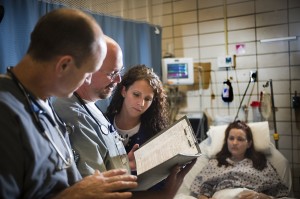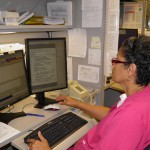24/7 Care via Remote Order Entry
LSU Innovates to Expedite Medication Processing
THE JOINT COMMISSION AND ASHP strongly recommend that, when feasible, hospitals provide 24-hour pharmacy review of medication orders. But for the many hospitals nationwide that close their pharmacy departments at night, orders must wait until the following day to be reviewed, long after a drug has been administered. The delay leads to inefficiency and an increased risk of medication errors.
“It becomes a retrospective, not a prospective or concurrent, review,” said Michael Dorman, M.S., R.Ph., inpatient pharmacy director at Earl K. Long Medical Center in Baton Rouge, La., part of Louisiana State University (LSU) Health Care Services. In addition, pharmacists at facilities without 24-hour pharmacies might spend half of the next day entering orders from the previous night. “It becomes chaotic, because you have to clear the queue of overnight orders, then take care of new ones,” he said. “So, mornings were very hectic.”
That all stopped with the advent of a new remote order entry system in the LSU Health Care Services health system that ensures around-the-clock pharmacist involvement in the medication administration process. Now, when pharmacists come on duty in the morning, their queue is clear.
Making the Most Efficient Use of Staff
Three of LSU’s five outlying hospitals currently use remote order entry, with a fourth scheduled to join the system soon. The 24-hour pharmacy at Earl K. Long serves as the clearinghouse for all remote orders.
It works like this: At closing time for the pharmacies at each rural hospital, the remote order entry system activates automatically. All medication orders are scanned and diverted to the 24-hour pharmacy at Earl K. Long, where they are reviewed and entered into the pharmacy information system for the originating hospital. After the order has been reviewed and approved, the medication can be retrieved from an automated medication dispensing machine located on the originating hospital’s nursing unit.
“Overall, this is an innovative way to get the job done. It frees us up from having to employ a pharmacist here overnight and makes the most efficient use of our available staff,” said Todd Fricker, R.Ph., a staff pharmacist at Lallie Kemp Regional Medical Center. The 25-bed hospital in Independence, La., was the first in the LSU system to use remote order entry when the system went live in May 2009. “There’s no break in service continuity between shift changes, and it expedites order processing,” he said.
A Flexible System
In 2010, the number of remote orders averaged 5,675 per month, or 28 percent of all orders entered at Earl. K. Long, according to Dorman. The increase in workflow there necessitated the addition of two overnight pharmacists, each working seven days on and seven days off. Even with the addition of staff, Dorman estimates that LSU Health Care saves nearly $541,000 annually, because remote order entry obviated the need for similar staff increases at the outlying hospitals.
“We’re essentially doing the same amount of work with two pharmacists that six pharmacists would typically perform,” he said.
At the same time, remote order entry puts nurses in closer touch with pharmacists, according to Danny Jackson, Pharm.D., system pharmacy director for LSU Health Care. “There’s quite a bit of interaction between pharmacists at Earl K. Long and nurse supervisors at the rural hospitals,” he said.
The fact that the LSU Health Care pharmacy information system was already standardized across all facilities (with all hospitals sharing the same computer server) made implementing the remote order entry system easier. With it, pharmacists can log in from any location and call up records of any patient within the LSU system.
“If you’re about to embark on remote order entry, the more the host and remote location systems are matched with regard to formulary, protocol, and processes, the smoother things will go,” said Jackson. “It’s a lot easier than having to go back and standardize things after the fact.”
He added that LSU has not yet determined the impact of remote order entry on medication error rates, because a number of performance improvement projects, such as bar-code medication administration, were implemented throughout the LSU system in a short time span. “It’s difficult to isolate the impact of each one,” Jackson said.
“Right now, we’re collecting data to compare pharmacy entry errors at the remote location [Earl K. Long] versus the home locations to see if any patterns or issues show up,” he said.












 If you want to contribute tutorials, news or other stuff please contact us. We pay 150 for each approved article.
If you want to contribute tutorials, news or other stuff please contact us. We pay 150 for each approved article. Consectetur adipisicing elit. Sed do eiusmod tempor incididunt ut labore.
Consectetur adipisicing elit. Sed do eiusmod tempor incididunt ut labore. This site uses valid HTML and CSS. All content Copyright © 2010 Newscast, Inc
This site uses valid HTML and CSS. All content Copyright © 2010 Newscast, Inc If you like what we do, please don't hestitate and subscribe to our
If you like what we do, please don't hestitate and subscribe to our